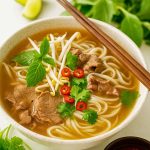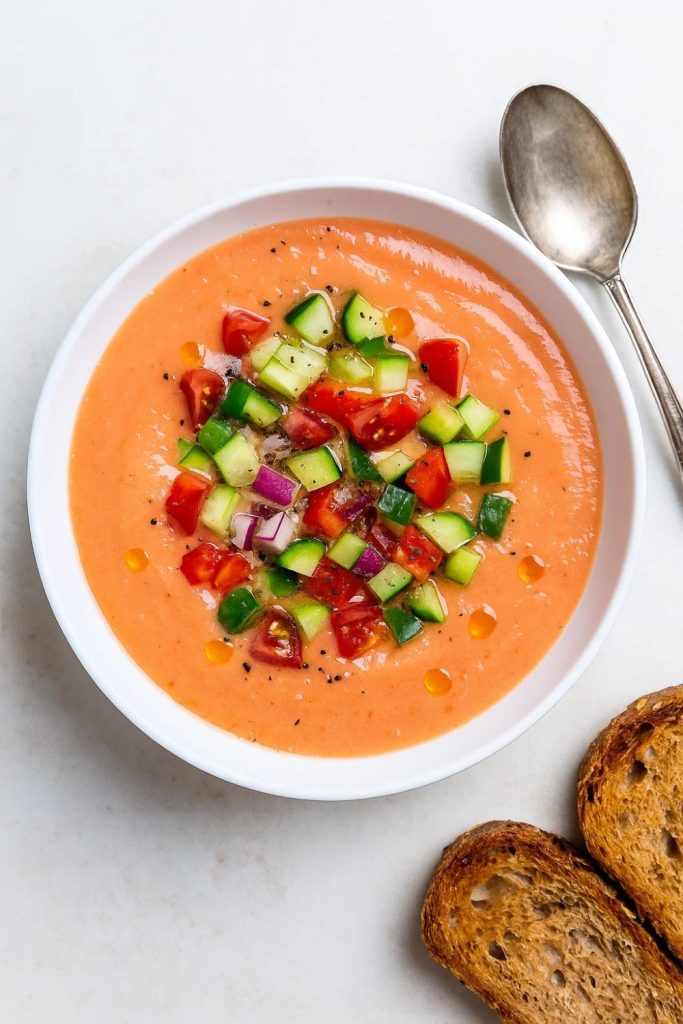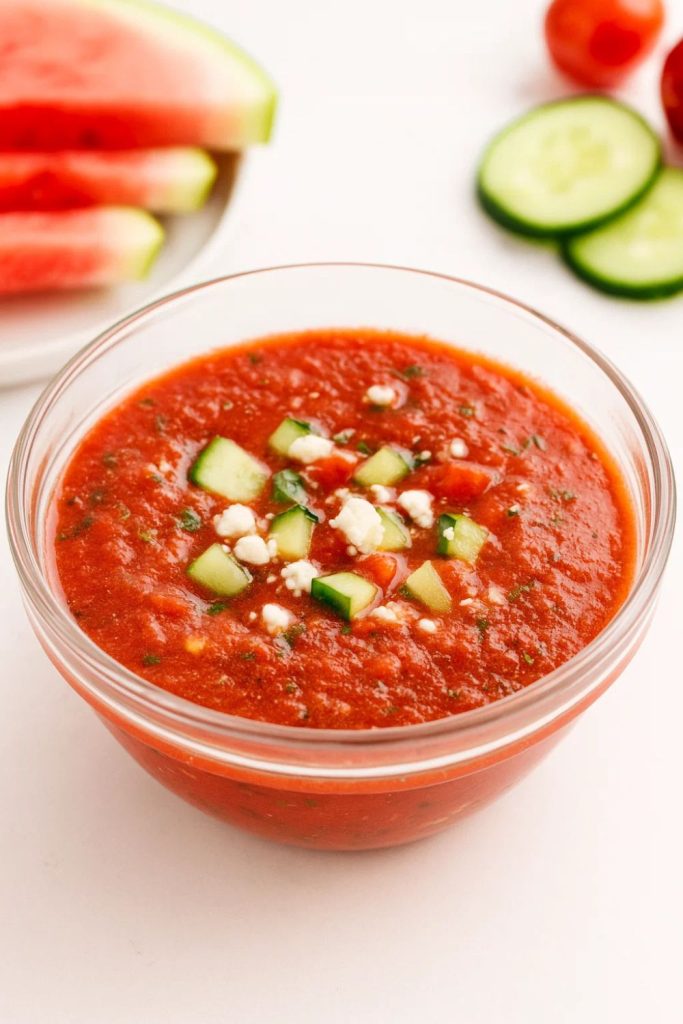There’s nothing quite as soothing, aromatic, and soul-warming as a steaming bowl of Vietnamese pho. With its richly spiced broth, tender noodles, and fresh toppings, pho brings comfort in every spoonful. This iconic dish isn’t just a meal—it’s an experience steeped in history and flavor.
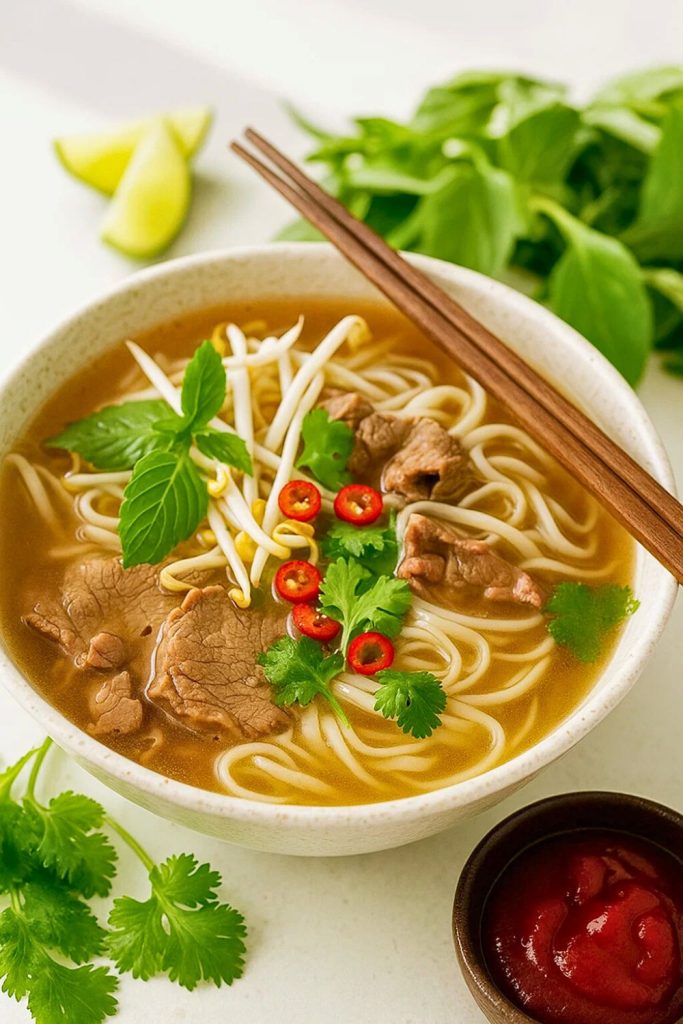
Whether you’re a longtime lover of Vietnamese cuisine or a curious home cook ready to try something new, this recipe for homemade pho is the perfect place to begin your journey.
It’s simple enough for beginners, yet flavorful enough to rival your favorite pho restaurant.
Pho is more than just a dish—it’s a tradition passed down through generations in Vietnamese households.
I first discovered the magic of pho while backpacking through Hanoi.
I remember ducking into a tiny street-side stall on a rainy afternoon, the air thick with the scent of cinnamon and cloves.
The vendor handed me a bowl filled with steaming broth, paper-thin slices of beef, rice noodles, and fresh herbs.
From the first sip, I was hooked.
It was a perfect balance of richness, spice, and brightness—the kind of meal that made you feel cared for.
That moment sparked a passion for recreating pho at home, learning to build flavor patiently, one layer at a time.
Now it’s become a comfort food in my own kitchen, and I’m excited to share the recipe with you.
Why You’ll Love This
1. Deep, Complex Flavor That Feels Authentic
What sets pho apart is its richly spiced broth—simmered slowly with aromatic ingredients like star anise, cinnamon, cloves, and charred onion and ginger. This layering of flavors creates a comforting depth that feels restaurant-worthy right from your own stove.
2. Surprisingly Simple to Make at Home
While pho might seem intimidating at first, it’s very doable with basic ingredients and a few hours of gentle simmering. You don’t need fancy tools or hard-to-find spices to create something truly special—just patience and love for good food.
3. Customizable for Every Diet and Craving
Beef pho (pho bo) is the classic version, but you can easily switch it up with chicken, tofu, mushrooms, or even shrimp. You also control the toppings—fresh herbs, bean sprouts, lime, chili, hoisin, or sriracha. It’s the ultimate customizable bowl!
4. Nourishing and Light Yet Filling
Pho is a naturally low-fat dish filled with rice noodles, protein, and fresh vegetables. It’s satisfying without feeling heavy, making it ideal for lunch, dinner, or even a light post-workout meal. Plus, it’s gluten-free if you use rice noodles!
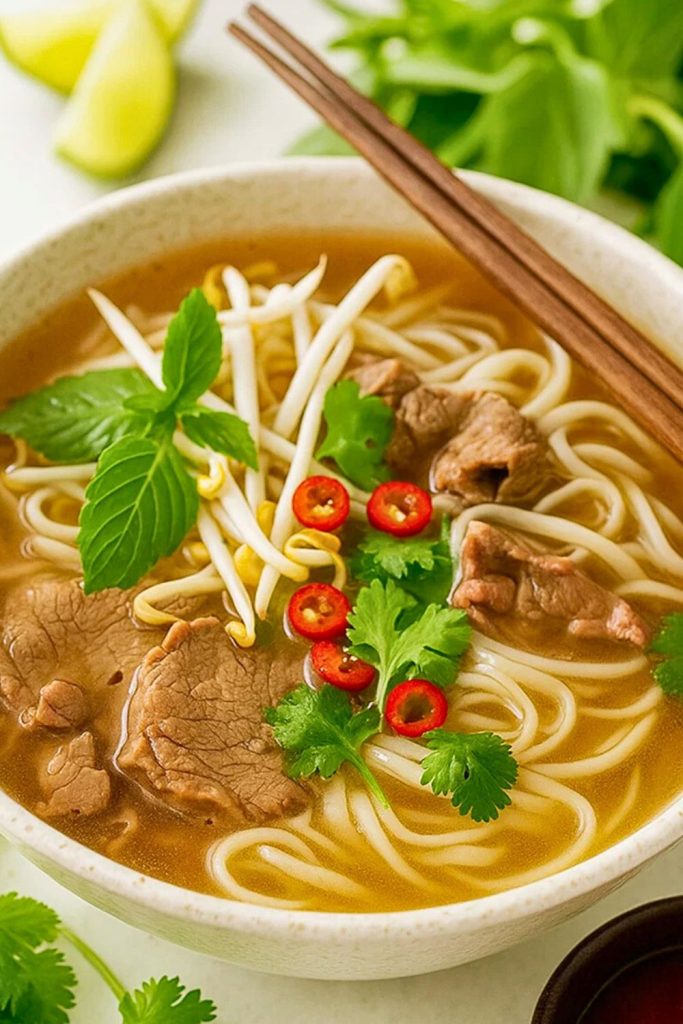
Recipe Details
- Prep Time: 20 minutes
- Cook Time: 3 hours (including simmer time)
- Total Time: About 3 hours 20 minutes
- Cuisine Type: Vietnamese
- Servings: 4 hearty bowls
- Estimated Cost: $15–20
Equipment Needed:
- Large stockpot or Dutch oven
- Strainer or fine mesh sieve
- Tongs
- Ladle
- Knife and cutting board
- Optional: Cheesecloth (for wrapping spices), small bowls for toppings
Ingredients
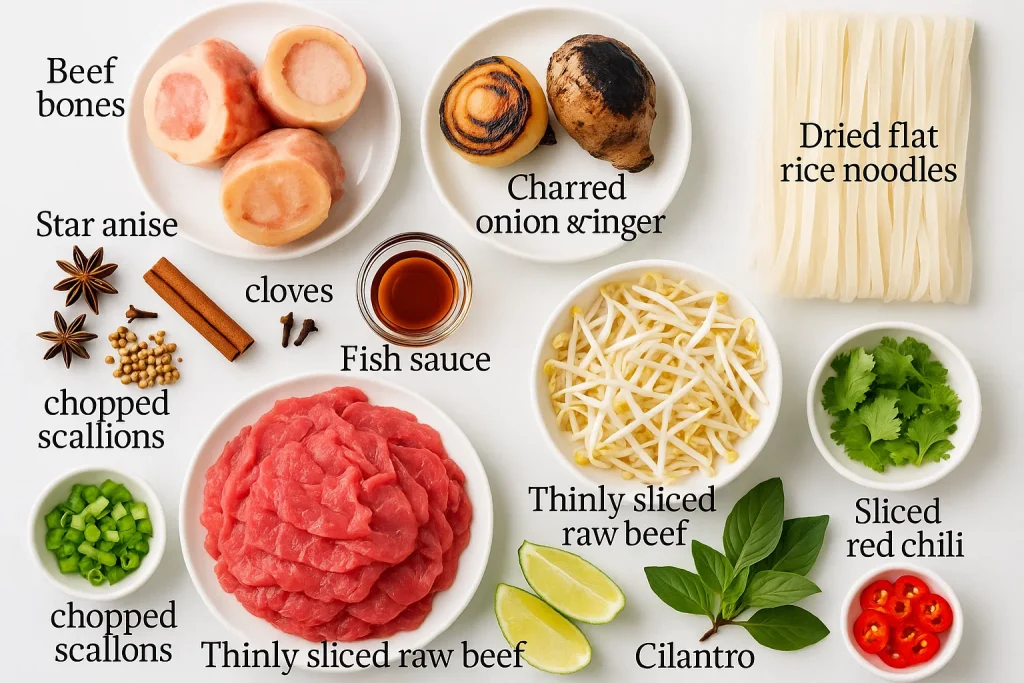
For the Broth:
- 2 lbs beef bones (preferably marrow and knuckle bones)
- 1 onion, halved
- 1 thumb-sized piece of ginger, halved
- 3 whole star anise
- 1 cinnamon stick
- 4 whole cloves
- 1 tsp coriander seeds
- 1 tbsp fish sauce (plus more to taste)
- 1 tsp salt
- 1 tbsp sugar
- 10 cups water
For the Bowls:
- 8 oz dried flat rice noodles (bánh phở)
- 1/2 lb thinly sliced raw beef (sirloin or eye of round works well)
- 1 cup bean sprouts
- 1 lime, cut into wedges
- 1/4 cup chopped scallions
- 1/4 cup chopped cilantro
- 1/2 cup Thai basil leaves
- Optional: Thinly sliced red chili, hoisin sauce, sriracha
Step-by-Step Instructions
1. Char the Aromatics
Place the halved onion and ginger directly over a gas flame or under a broiler until the surfaces are nicely charred—this adds a deep smoky flavor to the broth. Rinse off any black bits and set aside.
2. Parboil the Bones
To achieve a clean-tasting broth, add bones to a large pot, cover with water, bring to a boil, and simmer for 10 minutes. Drain and rinse bones under cold water. Clean the pot before returning bones to it.
3. Build the Broth
Add the cleaned bones back into the pot along with charred onion, ginger, spices, fish sauce, salt, sugar, and 10 cups of water. Bring to a boil, then reduce heat and simmer gently for 2.5 to 3 hours. Skim off any foam or fat as needed.
4. Strain the Broth
Using a fine mesh strainer or cheesecloth, strain the broth into a clean pot or bowl. Discard solids. Taste and adjust seasoning with more fish sauce or salt as desired.
5. Prepare the Noodles and Toppings
Cook rice noodles according to package directions, then rinse under cold water to stop the cooking. Arrange sliced beef, bean sprouts, lime wedges, herbs, scallions, and chili on a platter for serving.
6. Assemble the Bowls
Divide noodles among bowls. Place raw beef slices on top (they’ll cook slightly in the hot broth). Pour boiling hot broth over everything. Garnish with herbs and toppings of choice. Serve immediately.
Nutrition Facts (Per Serving)
- Calories: 450
- Protein: 30g
- Carbohydrates: 40g
- Fiber: 3g
- Fat: 18g
- Sodium: 950mg
- Vitamin C: 20% DV
- Iron: 25% DV
Tips for Success
1. Don’t Skip Charring the Aromatics
This step might seem skippable, but it adds a subtle smokiness and complexity that’s crucial to authentic pho flavor. Use tongs and broil or sear until the edges are blackened.
2. Parboiling Bones Is a Must
This removes impurities and prevents a cloudy, greasy broth. Always rinse bones after the first boil and use fresh water for the actual simmer.
3. Keep the Broth Simmering Gently
A rolling boil can break apart the bones and cloud your broth. Keep the heat low and steady for a clear, clean result.
4. Slice Beef Thinly and Against the Grain
To get those restaurant-style paper-thin slices, pop your beef into the freezer for 20–30 minutes before slicing. It firms up the meat, making it easier to cut.
Common Questions
Can I make this pho recipe with chicken instead of beef?
Yes! You can use a whole chicken or bone-in chicken parts to create a lighter pho ga (chicken pho). The method is similar but with shorter simmering time—about 1.5 to 2 hours.
What can I substitute for fish sauce?
If you need a vegetarian or allergy-friendly swap, try using soy sauce or coconut aminos. It won’t taste exactly the same but still adds umami.
Can I store the broth for later use?
Absolutely. Pho broth stores well in the fridge for up to 4 days and freezes beautifully for up to 3 months. Store noodles and toppings separately and assemble fresh when ready to eat.
My broth tastes bland—how do I fix it?
Pho broth should be deeply flavorful. Try adding a bit more fish sauce, salt, or a pinch of sugar to balance. A squeeze of lime juice also brightens up the flavor nicely.
Variations & Substitutions
Vegetarian Pho: Use vegetable stock and roasted mushrooms instead of bones and beef. Add tofu or tempeh for protein.
Spicy Pho: Add sliced bird’s eye chili directly to the broth or offer chili oil on the side.
Pho with Shrimp or Chicken: Shrimp adds a seafood twist, while shredded cooked chicken gives you a lighter protein option.
Low-Carb Version: Swap rice noodles with spiralized zucchini or shirataki noodles for a keto-friendly version.
Serving & Pairing Suggestions
Pho is a complete meal in a bowl, but it pairs wonderfully with:
- Fresh Vietnamese spring rolls
- A light cucumber salad with rice vinegar
- Iced jasmine tea or Vietnamese iced coffee
Classic Pho Recipe
Ingredients
For the Broth
- 2 lbs beef bones preferably marrow and knuckle bones
- 1 onion halved
- 1 thumb-sized piece of ginger halved
- 3 whole star anise
- 1 cinnamon stick
- 4 whole cloves
- 1 tsp coriander seeds
- 1 tbsp fish sauce plus more to taste
- 1 tsp salt
- 1 tbsp sugar
- 10 cups water
For the Bowls
- 8 oz dried flat rice noodles bánh phở
- ½ lb thinly sliced raw beef sirloin or eye of round works well
- 1 cup bean sprouts
- 1 lime cut into wedges
- ¼ cup chopped scallions
- ¼ cup chopped cilantro
- ½ cup Thai basil leaves
- Optional: Thinly sliced red chili hoisin sauce, sriracha
Instructions
- Place the halved onion and ginger directly over a gas flame or under a broiler until the surfaces are nicely charred—this adds a deep smoky flavor to the broth. Rinse off any black bits and set aside.
- To achieve a clean-tasting broth, add bones to a large pot, cover with water, bring to a boil, and simmer for 10 minutes. Drain and rinse bones under cold water. Clean the pot before returning bones to it.
- Add the cleaned bones back into the pot along with charred onion, ginger, spices, fish sauce, salt, sugar, and 10 cups of water. Bring to a boil, then reduce heat and simmer gently for 2.5 to 3 hours. Skim off any foam or fat as needed.
- Using a fine mesh strainer or cheesecloth, strain the broth into a clean pot or bowl. Discard solids. Taste and adjust seasoning with more fish sauce or salt as desired.
- Cook rice noodles according to package directions, then rinse under cold water to stop the cooking. Arrange sliced beef, bean sprouts, lime wedges, herbs, scallions, and chili on a platter for serving.
- Divide noodles among bowls. Place raw beef slices on top (they’ll cook slightly in the hot broth). Pour boiling hot broth over everything. Garnish with herbs and toppings of choice. Serve immediately.
Notes
This step might seem skippable, but it adds a subtle smokiness and complexity that’s crucial to authentic pho flavor. Use tongs and broil or sear until the edges are blackened. 2. Parboiling Bones Is a Must
This removes impurities and prevents a cloudy, greasy broth. Always rinse bones after the first boil and use fresh water for the actual simmer. 3. Keep the Broth Simmering Gently
A rolling boil can break apart the bones and cloud your broth. Keep the heat low and steady for a clear, clean result. 4. Slice Beef Thinly and Against the Grain
To get those restaurant-style paper-thin slices, pop your beef into the freezer for 20–30 minutes before slicing. It firms up the meat, making it easier to cut.
Make it a cozy weekend meal or a fun DIY dinner night with toppings served buffet-style!
A good bowl of pho is more than just food—it’s comfort, culture, and care in one fragrant spoonful. Whether you’re making it on a lazy Sunday or impressing friends with a weeknight dinner, this recipe will warm your soul and fill your kitchen with irresistible aromas.
Give it a try, experiment with toppings, and don’t forget the lime wedge! Wishing you happy cooking and even happier slurping.
